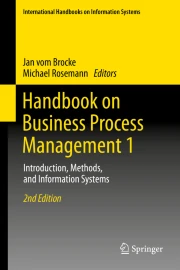
This is a preview of subscription content, log in via an institution to check access.
eBook EUR 181.89
Price includes VAT (France)Softcover Book EUR 232.09
Price includes VAT (France)Hardcover Book EUR 232.09
Price includes VAT (France)Tax calculation will be finalised at checkout
Business Process Management (BPM) has become one of the most widely used approaches for the design of modern organizational and information systems. The conscious treatment of business processes as significant corporate assets has facilitated substantial improvements in organizational performance but is also used to ensure the conformance of corporate activities. This Handbook presents in two volumes the contemporary body of knowledge as articulated by the world' s leading BPM thought leaders. This first volume focuses on arriving at a sound definition of BPM approaches and examines BPM methods and process-aware information systems. As such, it provides guidance for the integration of BPM into corporate methodologies and information systems. Each chapter has been contributed by leading international experts. Selected case studies complement their views and lead to a summary of BPM expertise that is unique in its coverage of the most critical success factors of BPM.
The second edition of this handbook has been significantly revised and extended. Each chapter has been updated to reflect the most current developments. This includes in particular new technologies such as in-memory data and process management, social media and networks. A further focus of this revised and extended edition is on the actual deployment of the proposed theoretical concepts. This volume includes a number of entire new chapters from some of the world's leading experts in the domain of BPM.
“This outstanding work, already updated in a second edition, is focused on business process management (BPM) definition, approaches, methods, and integration with process-centered information technology (IT) information systems. … Completely revised and updated after four years, this comprehensive handbook is a must for all modern business managers.” (Mihail Sadeanu, Computing Reviews, April, 2015)
Jan vom Brocke holds the Martin Hilti Chair in Business Process Management (BPM) at the University of Liechtenstein. He is Director of the Institute of Information Systems and President of the Liechtenstein Chapter of the Association of Information Systems (AIS). Jan has more than ten years of experience in BPM projects and serves as an advisor to a wide range of institutions. He has published his work in more than 150 refereed papers at internationally perceived conferences and journals and is an invited speaker on BPM at a number of universities, such as the University of St. Gallen in Switzerland, the LUISS University in Italy, or the University of California at Berkeley. In Liechtenstein, Jan is initiator and academic director of Europe’s first international university Master Program in Business Process Management. His PhD students regularly take part in doctoral consortia, just recently two of which have been awarded junior research fellows of the 3rd Lindau Nobel Prize Laureates Meeting in Economic Sciences.
Michael Rosemann is a Professor and Co-Leader of the Business Process Management Group at Queensland University of Technology, Brisbane, Australia. His research areas are Business Process Management, Enterprise Systems and conceptual modeling. He is the author/editor of seven books and more than 140 refereed papers (incl. MISQ, IEEE TKDE, JAIS, DSS, Information Systems) and Editorial Board member of seven international journals. His publications have been tr
anslated into German, Russian, Portuguese and Mandarin. Dr Rosemann’s PhD students have won the Australian award for the best PhD thesis in Information Systems in 2007 and in 2008. He is the founder and chair of the Australian BPM Community of Practice and has been the Chair of the 5th International Business Process Management Conference in 2007. He regularly conducts executive training in BPM and provides BPM-related advice to organizations from various industries including telecommunications, banking, insurance, utility, retail, public sector, logistics and film industry.